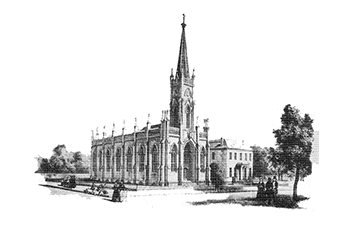James Oliver Van de Velde, S.J.
Second Bishop of Natchez A Biographical Sketch

BY J.E. GUERCIO
James Oliver Van de Velde was born near Termonde, Belgium, on April 3, 1795. At the age of fifteen he was sent to a boarding school near Ghent where he excelled. At the age of eighteen he became a teacher of French and Flemish and continued his studies of English and Italian. At the Archiepiscopal Seminary at Mechlin, he was a student and a teacher of Latin, French and Flemish.
Desiring the life of a missionary priest, the young Van de Velde had a providential meeting with Father Charles Nerinckx of Kentucky, one of the great missionary priests of the New World, who had just visited Rome, and was on his return to the United States. He offered his services to Father Charles and it was decided that Van de Velde complete his theological studies in the seminary of Bardstown, Kentucky.
In 1817, during the Atlantic voyage, Van de Velde had a serious accident on the ship which left him too weak to continue to Kentucky.
He was taken to St. Mary's Seminary in Baltimore to recouperate. Later, upon the guidance of Father Nerinckx, Van de Velde entered Georgetown College and the novitiate of the Society of Jesus rather than the seminary at Bardstown.
He was ordained to the priesthood by Archbishop Marechal on September 25, 1827. Van de Velde became a professed member of the Society of Jesus in 1837 at the New Jesuit College of St. Louis, Missouri.
During January of 1838, on a journey from St. Louis to New Orleans, Father Van de Velde stopped in Natchez for two weeks, ministering to the spiritual needs of the people. In 1840 he was made president of the University of St. Louis. In 1843 he became Vice-Provincial of the Society of Jesus. On December 1, 1848, he was appointed the second Bishop of Chicago. He was consecrated Bishop on February 11, 1849, in the Church of St. Francis Xavier which is attached to the University of St. Louis.
In 1852 after the close of the First Plenary Council of Baltimore, Bishop Van de Velde was chosen to take the decrees to Rome for approval. While in Rome he requested that the Holy See transfer him from Chicago since the cold climate aggravated his rheumatism. Accordingly, Pope Pius IX issued a brief transferring him to Natchez in July 29, 1853, one year after Bishop Chanche’s death, the founding bishop of Mississippi. Bishop Van de Velde took possession of his See in Natchez on December 18, 1853.
Although the good bishop had a fine house for himself, he inherited a cathedral that was unfinished and in debt. Father Mathurin Grignon was rector of the Cathedral and Bishop Van de Velde depended on his years of experience in Natchez to care for diocesan affairs. On April 29, 1855, Bishop Van de Velde was in New Orleans lecturing and attempting to collect some funds when he wrote to Father Grignon about slate roofing for the cathedral: “ I hope that when the church is finished we will be able to cover the Bishop’s residence with the same material.”
For a limited time, Bishop Van de Velde obtained possession of the old Spanish burying ground, now Memorial Park. He enclosed the graveyard with a high fence, collected the scattered human remains and placed them in a brick crypt under the Sanctuary in the Cathedral. In hopes of establishing a Jesuit college, he acquired the Rose Hill property from the three Marcilly sisters. But, due to a lack of sufficient priest, the Jesuits were unable to accept the Bishop’s proposal.
On October 23, 1855, the Bishop fell on the front steps of his residence and fractured his leg. He died on November 13, 1855, of yellow fever which also killed forty parishioners. He was buried in the cathedral crypt until 1874 when his Jesuit brothers took his remains to Florissant, Missouri. The Jesuit cemetery was relocated in Calvary Cemetery in St. Louis, Missouri, in 2006.
